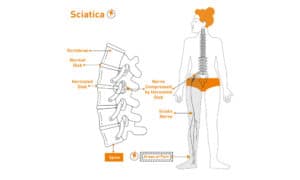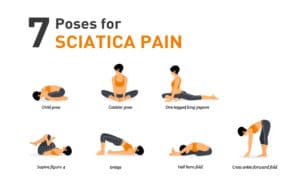All About Sciatica Left & Right Side: Causes, Symptoms & Treatment
, 5 years ago
Overview of Sciatica
Do you ever feel a pain that runs down your leg? This exactly points toward Sciatica.
Sciatica is quite common, affects almost 40% of adults and easy to identify. Sciatica pain traverses through the sciatic nerve, that starts in your lower back and extends to run through your hips, buttocks, legs and feet on both sides. This is the most distinctive sign of sciatica pain. The nerve pain occurs due to irritation of the sciatic nerve.
The longest nerve of our body is the sciatic nerve and it’s one of the important nerves in the body as it has a direct effect on your ability to control and feel your legs. The sciatic nerve divides (behind the knee) itself into the peroneal and tibial nerves which allow movement and sensations in the thighs, knees, calves, ankles, feet and toes.
Sciatica is nothing but a pull sensation that establishes into moderate to severe pain and turns out to be more frequent in people who bend, lift and sit a lot.

Check if you have sciatica?
Sciatic pain is often described by people in different ways depending on the severity and the compression on the affected nerve root. Some people describe it as sharp & electric, or stabbing & shooting or jolts of pain. The pain might come and go or sometimes remain constant. The sciatica pain is generally felt more severely in your leg than your lower back.
The pain may worsen with movement; for instance, when you –
- sit or stand for an extended time
- rise from sitting or lying down(sit-to-stand).
- twist your upper body
- do a forced, sudden body movement such as coughing, sneezing.
- experience a jerk while travelling
- lift/pull heavyweight
Note that no two sciatica pain episodes are similar as they can vary from annoying dull pain to excruciating pain.
Below are the symptoms of sciatica: –
-
Calfpain
-
-
a pull sensation from your lower back to buttocks and thigh, it further feels from calf to the foot.
-
A pain in your butt or leg that worsens while prolongedsitting
-
Numbness in your leg or foot
-
Tingling sensation in your extremity (lower body)
-
Persistent pain on one side of your butt
-
Muscle weakness in the distressed leg or foot
-
Shooting pain down the leg which makes it tuff to stand up or extend the knee
-
Pain in one part of the leg while numbness in another part
-
A sensation of pins and needles only in toes or feet
When should I seek medical help for sciatica?
If the pain is only in the back and is mild in nature, it may fade away with rest and precautions, but as soon as the pain radiates below the hip giving rise to sciatica- it must be addressed before the symptoms get worse.
If your self-relief measures fail to work and your symptoms last longer or worsen progressively, then you must seek immediate medical help.
Watch out for the following signs that indicate medical intervention: –
- Sudden, excruciating pain in the lowerback or leg along with numbness, tingling or muscle weakness in your leg, especially the foot.
- Pain after an injury, ex-accident
- Difficulty or trouble in controlling your bowel/bladder
- Poor control on balance
- Slipping of slippers from the foot for unexplained reasons
- Unable to take weight on the affected leg
Can sciatica affect the left and right side both?
Generally, sciatica affects only one leg at a time but sciatica can occur in both the legs too. Some people who experience multiple sciatica episodes, sometimes get sciatica on one leg and then years later, on another one. You may feel pain only in one leg while numbness in another leg. The pain might extend to your foot or toes depending on the spot where your sciatic nerve has been affected.
What causes sciatica?
Sciatica pain occurs when a root that forms one of the sciatic nerves is irritated or pinched, which gives rise to pain anywhere along the branch from the low back, butts, leg, calf to the foot.
The most common cause for sciatica is a herniated disc i.e slipped disc or a pinched nerve. Due to injury or trauma, the vertebra may slip forward or discs may weaken over time and the nerves get compressed. However, it is often the gradual outcome of bending, sitting for several years.
Sciatica can be caused due to different conditions listed below: –
- Herniated or slipped disc – Discs are the cushions between each vertebra of spine and pressure from them can cause the disc to bulge out which puts pressure on the sciatic nerve.
- Deconditioned or weak spinal muscles.
- Spinal stenosis – abnormal narrowing of spinal canal i.e. the part of the spine where the nerve passes through, that pinches the sciatic nerve roots as they exit the spine.
- Spondylolisthesis – when one of the vertebrae in your spine slips out of position, narrowing the opening through which the nerve exits.
- Degenerative spine – wear and tear of spine structures which may irritate the sciatic nerve.
- Piriformis syndrome – an uncommon neuromuscular condition that happens when the piriformis muscle becomes tight, puts pressure and irritates the sciatic nerve.
- Back injury
- During or post-pregnancy
- Lifestyle factors such as wearing high heels frequently, obesity, professions that demands prolong sitting or repetitive bending and lifting.
How is sciatica diagnosed?
After a detailed history, the spine specialist will check your spine thoroughly as
Sciatica gives a strong history which helps in drawing the diagnosis.
Your doctor will then conduct a physical and neurological examination to check what kind of movements relieve or aggravate your symptoms. This includes assessment for muscle strength, decreased or abnormal sensation and reflexes.
You may be asked to do some stretching and movement to find out those activities that influence pain.
Nerve tests may be done to examine how nerve impulses are being conducted by sciatica nerve and it may help pinpoint the area involved.
Other than movement testing, some imaging also helps in diagnosis. These radiodiagnoses could be X-Ray, CT Scan or an MRI.
Imaging tests will let the doctor know the cause of your sciatica.
However, the symptoms on examination need to be correlated and confirmed without relying only on imaging. This is how the diagnosis is confirmed.
What can I do to treat sciatica?
Home remedies to reduce pain and increase mobility works in acute episodes.
You could do the following to help relieve your pain: –
- Apply ice or heat therapy.
- Do gentle stretches and strengthening exercises.
- Continue your regular activities as much as possible and keepmoving to avoid recurring attacks.
- Avoid activities that aggravate your symptoms.
- Avoid any exertion and stress.
Take over the counter medicines for pain relief.

Can my diet affect sciatica?
You can relieve your sciatica pain by altering what you eat to some extent. Magnesium-rich and anti-inflammatory foods are usually suggested as they help in releasing muscle contraction and inflammation.
Hence, follow these tips to keep sciatica pain at bay.
- You should eat more fibre-rich foods and include fresh fruits and vegetables.
- Eat fresh berries and pineapples, they aid in healing and boostthe immune system.
- Include turmeric, ginger and garlic to your foods.
- Add foods rich in vitamins – D3, B12, calcium and omega-3 essential fatty acids to your diet.
- Include electrolytes in your meal such as coconut water.
- Drink plenty of waterto wash off toxins and inflammatory agents which may worsen your pain.
Root Cause Management of Sciatica
Spine rehabilitation is the answer to permanent relief from Sciatica. Your Spine specialist will test your spine muscles through a test called
DSA (Digital Spine Analysis) to know the exact percentage of load on your spinal muscles and design a precise treatment plan. This treatment plan or spine rehab includes targeted soft tissue(muscle) strengthening and proprioceptive (the body’s ability to sense itself) training.
It is recommended to continue exercises, adopt an active lifestyle and follow postural hygiene to prevent recurrences.
Takeaway
Here are 5 quick tips to cope up with sciatica pain –
- Active lifestyle
- Strengthen your spine muscle
- Avoid sustained positions such as prolonged sitting
- Take posture breaks every hour.
- Practice good posture by maintaining S-shape of your spine.
- Keep a check on your weight.
Sciatica pain has a good recovery rate and can be managed easily through precise spine rehabilitation.



